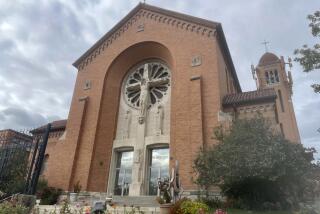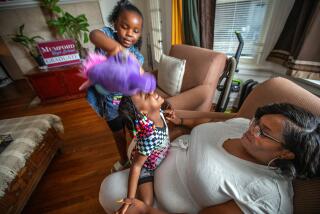Day Bittersweet for Detroit’s Aging Parishes
- Share via
DETROIT — It is a morning just before Christmas.
Outside, on the broken streets around Sweetest Heart of Mary Catholic Church, on Russell and Canfield on Detroit’s near east side, there are no signs of the season.
Just the gray silence of economic devastation.
Acre after acre of bramble-filled vacant land. Abandoned buildings. And a lone figure, leaning into the chilled wind, slogging past the public housing across the street.
Ah, but inside, inside Sweetest Heart of Mary.
Inside the largest Catholic Church in Detroit; underneath its twin, 217-foot cathedral spires, its vaulted ceiling; around the thick, 80-foot- high marble columns and pendulous chandeliers; off the spectacular 19th-Century floor-to-ceiling stained glass windows: a deep, sweet, baleful sound bounces and echoes and engulfs the approaching noontime.
Alone in the enormous, 100-year-old Polish church, a wondrous spiritual cavern built to hold a congregation of 2,400, Bernard Topolewski is at the Austin Opus II organ, the only one of its kind left in the world, playing “O, Holy Night” for himself and for his God.
Topolewski, a short, dapper Pole with a clipped, Old World mustache, comes almost every day to Sweetest Heart, to practice alone or play for Masses that are still said in both Polish and English.
Here is where he is at peace. Almost able to see his breath, the church heat off until it is time for the first Christmas Masses, Topolewski limbers and relaxes his hands in the cold by bringing out the Christmas joy hidden in the Austin organ.
Yet there is a lonely mournfulness in his music now too. For Topolewski carries with him the bitter knowledge that this may be the last Christmas ever for Sweetest Heart of Mary.
Closing Plan
The Archdiocese of Detroit wants to close Sweetest Heart of Mary Catholic Church.
“Places like this . . . can never be replaced,” Topolewski says quietly, sadly, surveying the church’s long, wide nave from the choir loft.
Sweetest Heart of Mary, built with the sweat of Polish immigrants who burst upon Detroit before the turn of the century, is one of 43 Catholic churches in the city targeted for closing under a highly controversial consolidation plan proposed last September by Cardinal Edmund Szoka, Detroit’s Archbishop.
The sweeping plan, affecting a third of the parishes in the city, is unprecedented in the history of the U.S. Catholic Church. It is designed to confront the massive population losses that have ravaged Detroit over the last two decades, the unabated white flight to the suburbs that has left dozens of Catholic churches around the city standing as huge monuments to Detroit’s past.
Church officials argue that some of these city churches, including Sweetest Heart of Mary, are peopled only by white suburbanites, city natives who have moved out of predominantly black Detroit but who remain loyal to their old churches, commuting in only for Sunday Mass. The archdiocese insists that many Detroit churches thus have few real ties to the city or its impoverished black community.
Only Deaths, Funerals
“In some of these churches, you only have deaths and funerals happening, you have no new members coming in, you have no sacramental life,” says Brenda Marshall, a spokeswoman for the archdiocese. “That was the most important consideration (in choosing which churches to close), whether the church was alive.”
While some targeted parishes are heavily black, church officials say that most blacks in the city are Baptist, and that the Catholic Church has been unsuccessful in attracting many to its fold. For those blacks that are Catholic, they add, there will still be plenty of inner-city churches for their parishes to merge into even after the closings.
“In some cases, we have three churches within a space of three or four blocks of each other,” says Marshall. “What we are talking about is an excess of buildings.”
As Christmas approached, Szoka was reviewing the proposed closings, and now plans to announce his final decision right after the holidays, in early January, on which churches to shutter.
Virtually every targeted parish has passionately appealed the plan.
But so far, Szoka has indicated that he will stick to his guns and go through with most of the closings--adding a new and special kind of abandoned building to the city’s littered landscape.
“Various difficulties and pains and anxieties and crosses come into our lives,” Szoka said in a recent interview with the Detroit Free Press editorial board. “That is part of the Christian life, to carry the Cross. I am not worried about those accepting it. It will be painful, but they will accept it.”
Yet, if Szoka imposes the threatened closings, he will do so in the face of a firestorm of protest from throughout the city, from parishioners, civic leaders and even his own priests.
Even while preparing for Christmas, many of the city’s parish priests have also been preparing to fight their religious superior. Some have already sought to go around Szoka by contacting Vatican representatives, says Father Robert McGrath, pastor of St. Frances De Sales, a targeted church on Detroit’s west side that serves a predominantly black, inner-city congregation.
“One of the biggest problems we have to face now is Szoka’s arrogance,” says an angry McGrath.
‘Not Shell Station’
“This is not like closing a Shell station,” he adds. “A parish plays many roles in the neighborhood. And I don’t think the people are going to let this church close. They just won’t close it.”
McGrath and others stress that most of the threatened parishes are financially self-sufficient, have growing congregations and are not drains on the archdiocese. McGrath says Szoka just wants to alleviate a shortage of priests by closing city churches and moving their pastors to growing suburbs. He believes the closings have little to do with the health of the affected parishes; in fact, those involved in the closing plan never even visited his church, he says.
Many priests have thus been surprised and bewildered to find their parishes on the closing list, including Father Alphonse Gorecki, a quiet, rumpled Polish immigrant, the pastor and lone priest at Sweetest Heart of Mary.
“I pray for Cardinal Szoka, and he prays for me,” says Gorecki, when asked how he feels about the closing plan.
Alone in Sweetest Heart’s huge rectory with his Doberman guard dog, Heidi, Gorecki tries to understand, but he cannot. After all, he says, reading from the written appeal he presented to the archdiocese earlier this month, Sweetest Heart of Mary’s membership and contributions have steadily increased throughout the 1980s, as more and more young Polish-Americans living in the suburbs have sought out the church as a way to recapture their roots.
The argument that the congregation is aging is wrong, he adds. Weddings and baptisms are actually up sharply from the lows of the 1970s. Each Sunday, 300 to 400 parishioners attend Mass, with 2,500 there for midnight Mass on Christmas Eve.
“The majority of our new members are young people, some joining a church for the first time,” says Gorecki. “People want tradition.”
Financially, the parish is a net contributor to the archdiocese; even Gorecki’s salary is paid for by the congregation. More than $300,000 has been poured into the church’s restoration in the 1980s, and none of the money came from the archdiocese. “We don’t get a penny from the archdiocese,” he says.
White, Suburban
The congregation is virtually all white and suburban, but, Gorecki asks, what is wrong with that?
“We need to be realistic, there’s not much of a neighborhood here, anyway,” says Gorecki. “The door is open to anyone, but who is to say that blacks shouldn’t go to a Baptist church?”
But the time for arguments at Sweetest Heart may be over. The parish has presented its written appeal; now it must wait. The people of Sweetest Heart of Mary wait for terrible news on what should be the most joyous day of the Christian year.
“This is disrupting the faith of the people,” says Topolewski. “Instead of thinking about Christmas, Szoka’s got people worrying about their churches.
“What is the Cardinal’s Christmas message to the people going to be like?” he asks.
“What’s he going to do, wish them Merry Christmas and then take away their churches?”
More to Read
Sign up for Essential California
The most important California stories and recommendations in your inbox every morning.
You may occasionally receive promotional content from the Los Angeles Times.













